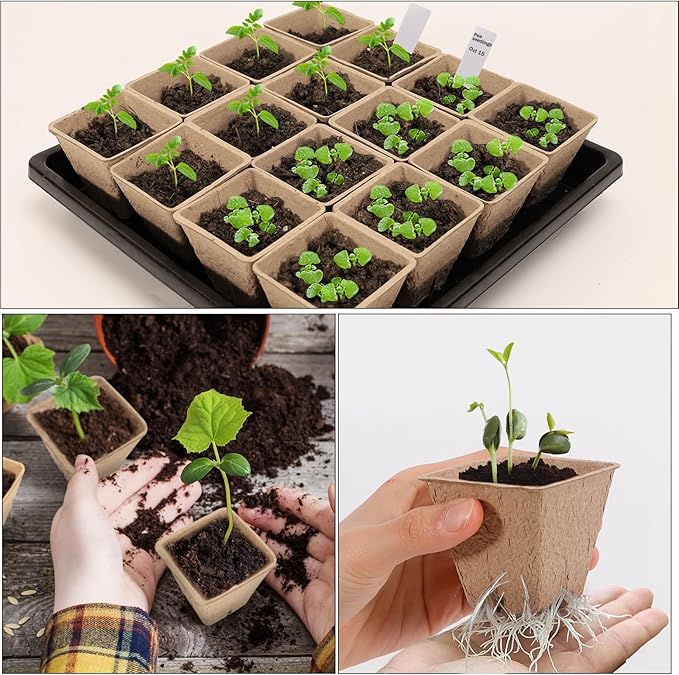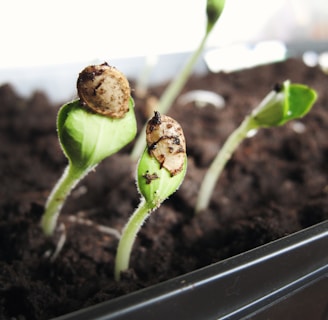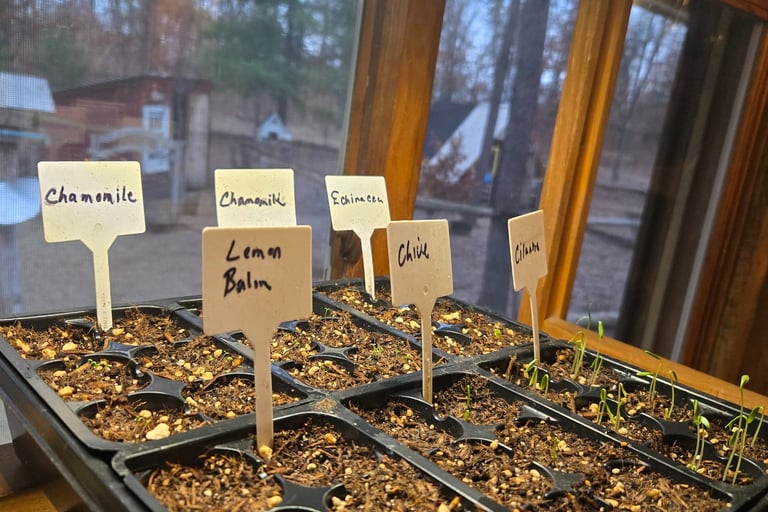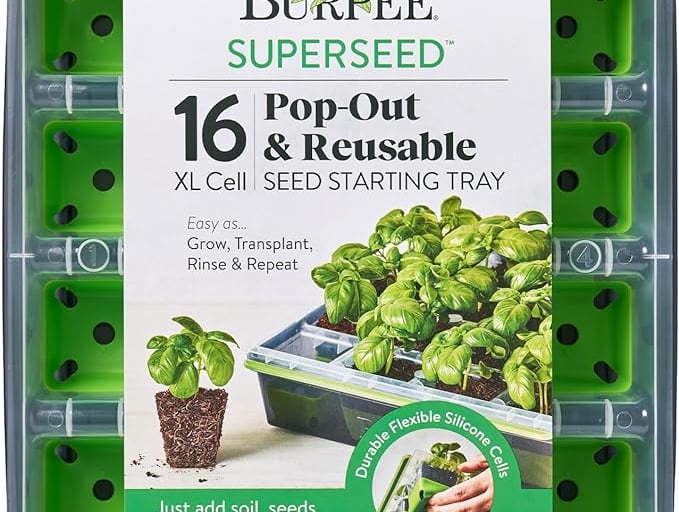Seed Starting Trays: Your Shortcut to Garden Success!
Discover how seed starting trays can boost your gardening success. Learn easy tips to grow strong seedlings indoors with reliable seed starting trays today!
GARDENING


Gardening can be a relaxing and rewarding hobby, especially when you find tools that simplify the process. One such tool I've discovered is the seed starting tray. Before using seed starting trays, I often had trouble getting my seeds to sprout evenly or grow healthy seedlings. Once I began using these trays, however, I quickly realized how much easier and more effective my gardening became.
Seed starting trays are simple plastic or biodegradable containers divided into small sections, each designed to hold one or two seeds. They allow gardeners to start their seeds indoors, giving the plants a head start before transferring them outdoors. This is especially helpful in places where spring weather can be unpredictable. Instead of planting seeds directly into the garden and risking damage from frost or pests, you can safely nurture them indoors first.
The first time I used seed starting trays, I was surprised by how quickly and evenly my seeds germinated. Instead of dealing with scattered growth, where some plants sprouted quickly while others struggled, the trays provided a controlled environment. Each little compartment had exactly the right conditions—just enough soil, water, and space—for a seed to grow into a strong seedling.
One major advantage of using seed trays is better control over watering. Watering can be tricky when seeds are planted directly into garden soil. It's easy to accidentally overwater or underwater seeds, which can stop them from sprouting. With seed trays, the compartments help control moisture levels. Each cell is small, so it's easy to tell when the soil needs watering and how much water to give. This prevents common issues such as seed rot or mold growth.
Another benefit I noticed was the ease of keeping seedlings warm and in good lighting. Because seed starting trays are lightweight and portable, you can move them around to get the best conditions. If one window is too sunny or too cold, it's simple to move the tray to another location. This flexibility helps seedlings get the consistent warmth and sunlight they need to grow strong and healthy.
Seed trays also make it easy to organize seedlings. When you're growing many different kinds of plants, it's helpful to label each compartment. This means no confusion about which seedlings are tomatoes, peppers, cucumbers, or flowers. In the past, I would plant seeds directly into larger pots or garden beds, and after a few weeks, I struggled to remember exactly what I'd planted and where. The organized layout of seed trays makes it simple to keep track.
One key advantage to starting seeds indoors in trays is protecting seedlings from pests and weather damage. Young seedlings grown directly outdoors often face threats like hungry insects, squirrels, or unexpected weather changes. Using seed trays indoors reduces these risks significantly. Seedlings have time to grow stronger roots and stems before being exposed to outdoor conditions. This early strength helps them survive and thrive once transplanted outdoors.
Transplanting seedlings from trays into the garden is also easier and less stressful on the plants. The small compartments allow you to remove each seedling gently without damaging its roots. I used to worry about damaging roots when separating seedlings grown together in one pot, but with seed trays, that problem disappeared. Seedlings simply slide out of their compartments with their root systems intact, reducing shock and improving the plants' chances of survival after transplanting.
Additionally, seed starting trays are affordable and reusable, making them budget-friendly gardening tools. Plastic trays can be used multiple seasons if cleaned and stored properly. Even biodegradable trays, made of peat or coconut fiber, have advantages—they can be planted directly into the ground, breaking down naturally and nourishing the soil.
I’ve experimented with various types of trays. Plastic trays are great for long-term reuse and often come with clear lids that help maintain humidity levels, creating a mini-greenhouse environment. Biodegradable trays offer convenience because you can transplant them directly into the garden without disturbing the seedlings at all. Both have worked well for me, depending on the type of plants and the gardening project.
Using seed trays also encourages early planning and garden organization. I’ve found myself spending more time in late winter carefully choosing seeds and planning my garden layout. Since trays have limited space, I’ve become more intentional about what I grow, selecting only seeds I truly want to nurture. This planning leads to less waste, healthier plants, and a garden that feels carefully designed rather than random or rushed.
The trays have allowed me to grow plants that previously seemed difficult. Plants like peppers, tomatoes, herbs, or delicate flowers can struggle when planted directly outdoors due to their sensitivity to temperature and moisture changes. Starting these seeds indoors in trays has dramatically increased my success rates. Now, I regularly grow healthy tomatoes and peppers, something I struggled to do before.
Another valuable lesson I've learned through seed trays is patience and careful observation. Because seedlings grow in a controlled, visible environment, you quickly notice if something isn’t right. Maybe a seedling looks weak or has trouble standing straight. You can then correct the conditions—such as moving the tray to better sunlight or adjusting watering—before issues become severe. Seed trays encourage mindful gardening, paying attention to detail and learning from small successes or mistakes.
Proper drainage is another important factor in seedling success. Seed trays usually have small drainage holes at the bottom, which help excess water escape. Good drainage prevents seedlings from developing root rot, a common problem in poorly draining containers or heavy garden soil. By keeping seedlings in well-drained trays, you’re helping them establish strong roots from the very beginning.
I've also discovered that seed trays help maintain cleanliness indoors. Before using trays, planting indoors often meant dealing with messy pots and dirt scattered around. Seed trays keep soil contained and organized, minimizing the cleanup afterward. This simple feature makes starting seeds indoors practical, even for gardeners with limited indoor space or who prefer to avoid extra mess.
An important tip when using seed trays is timing your planting carefully. Starting seeds too early means seedlings could outgrow the trays before outdoor planting conditions become ideal. On the other hand, starting too late means plants won’t mature fully before the growing season ends. I've learned to check seed packets for recommended indoor planting schedules based on local climate conditions. This small planning step makes a significant difference in gardening success.
Seed trays have allowed me to experiment more freely as a gardener. Since each tray can hold many plants, it's easy to try new plant varieties without feeling overwhelmed. I now regularly include new vegetables and flowers in my trays just to see how they grow. Sometimes these experiments become new gardening favorites, and sometimes they serve as helpful learning experiences. Either way, seed trays have made it easier and less stressful to explore gardening beyond my usual comfort zone.
Finally, seed starting trays can be great for teaching gardening to beginners or children. Their small size and clear results offer immediate rewards and visual learning opportunities. I've enjoyed using trays to introduce gardening to family members and friends who previously believed they lacked a green thumb. Seeing their seeds sprout quickly and evenly helped build their confidence and sparked a genuine interest in gardening.
Seed starting trays might seem simple or basic, but their benefits for home gardeners are enormous. They provide better germination rates, healthier seedlings, easier management, and less frustration. Since adopting seed trays, my gardening success has improved significantly. Each season, I'm reminded of their value when I transplant strong, healthy plants into my garden beds, knowing I gave them the best possible start. Gardening with seed trays has truly transformed my gardening experience, and now I can't imagine starting seeds any other way.
Interested in how to grow great tomatoes? Check out our post "Garden Gold: The Secret to Juicy Tomatoes All Summer Long!"






Support@rusticrootshomestead.com
© 2024 Rustic Roots Homestead - All rights reserved.
